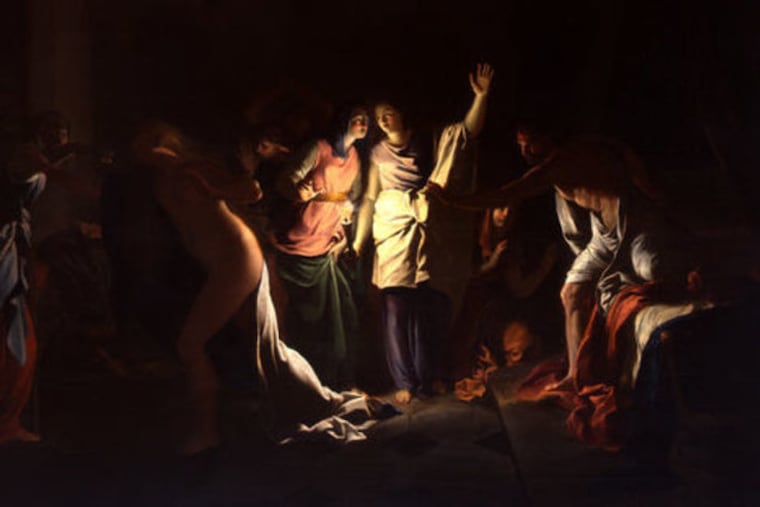La Salle plan to sell museum masterpieces stuns art community
The university is selling the art to raise revenue for initiatives in its new strategic plan

La Salle University, which has struggled to plug a projected deficit in recent years, plans to sell 46 pieces of art from its prized museum collection to help fund teaching and learning initiatives in its new strategic plan, officials said Tuesday.
The sale, which includes masterpieces by Jean-Auguste-Dominique Ingres, Georges Rouault, and Albert Gleizes, could raise more than $7 million, officials estimate.
Approved by the school's board of trustees and announced by university president Colleen M. Hanycz, the decision "is a strategic and good use of our assets," university spokeswoman Jaine Lucas said. "We are doing what we feel is in the best interest of our students."
It follows similar steps by other universities around the country in recent years to help stem financial woes — although some schools that have sold or attempted to sell art have faced challenges.
At Brandeis University in Massachusetts, a plan to close its museum and sell its art was reversed after backlash from students and faculty and legal action. Randolph College in Virginia was roundly criticized for its decision to sell a George Bellows painting worth more than $25 million.
The same controversy could follow the decision at La Salle, a 3,200-student Catholic university in Philadelphia's Logan section, whose collection composes one of the most highly regarded university museums in the region. Just hours after the announcement, members of the local art community began questioning the decision.
"This sort of feels like they're robbing Peter to pay Paul, and it's going to change the museum," said Ron Rumford, director of Dolan/Maxwell, private art dealers in Philadelphia.
La Salle officials said they need the revenue to invest in the university's core mission — teaching and learning — and made the decision after months of study.
The sale of the items, mostly paintings but also sculptures and drawings, is expected to raise from $4.8 million to $7.3 million, according to Christie's, the auction house handling the sale, Lucas said. Christie's identified five pieces as having the greatest potential for raising revenue, she said.
They are: Dame Elisabeth Frink's sculpture Walking Madonna; Ingres' Virgil Reading the Aeneid Before Augustus from 1865; Dorothea Tanning's Temptation of St. Anthony; Rouault's Le Dernier Romantique (The Last Romantic); and Gleizes' Man in the City (L'Homme Dans la Ville).
The five pieces alone could bring in between $2.3 and $3.45 million, Lucas said.
Lisa Tremper Hanover, formerly president of the Alliance of Academic Museums and Galleries, who also led the Berman Museum of Art at Ursinus College for 25 years, said many museums sell art but then use the proceeds for the benefit of the museum and the collection.
"I am shocked," she said upon hearing of the plan. "That is such a distinctive aspect of La Salle University."
Not on the list for sale is the painting Mary by Henry Ossawa Tanner, because it is most often used by faculty in classes and has significant historical value, Lucas said.
Of the 46 items targeted for sale, 36 are currently on display in the museum and will be removed this week; the 10 others will be taken from storage, she said.
The items on display will be replaced with others in the university's collection, which consists of close to 350 paintings, 65 sculptures, 500 drawings, 3,000 graphic prints, 175 photographs, and a few items of furniture and decorative art, according to its website. The museum, housed in the lower level of Olney Hall in the heart of campus, will remain open and used for teaching.
"The art museum will continue to support the pedagogical mission of La Salle," said Lucas, the spokeswoman.
The school was started and is run by the Christian Brothers order. Many of the works were acquired by Brother Daniel Burke, who founded the museum and served as La Salle's president from 1969 to 1976.
"He was an incredible connoisseur of art," said Susan Dixon, chair of the art history department at La Salle. "I've only been here 5½ years, and I came because of the collection."
She said faculty members regularly use the collection in their teaching. She declined to comment on the university's decision to sell some of the art.
Lucas said La Salle believes it is "clear and free" to sell the pieces selected and noted the plan has the endorsement of the Christian Brothers.
Like other schools, La Salle has struggled with an enrollment decline and deficit in recent years. In 2015, freshman enrollment plummeted 18 percent, or 159 students, from the year before, and 23 staff members were laid off. The school faced a $12 million deficit in its $132 million budget.
Since then, the university has lowered its tuition sticker price, launched a marketing campaign, and announced plans to eliminate some programs, helping to offset the shortfall. Lucas declined to say whether the university is projecting a shortfall this year but said the school finished last year with a surplus.